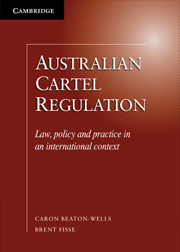Book contents
- Frontmatter
- Contents
- About the authors
- Preface
- Acknowledgements
- Abbreviations
- 1 Introduction
- 2 The legal framework governing cartel conduct
- 3 Collusion (contracts, arrangements, understandings)
- 4 Cartel and other provisions
- 5 Fault elements of the cartel offences
- 6 Individual liability for cartel conduct
- 7 Corporate liability
- 8 Exceptions
- 9 Enforcement policy
- 10 Immunity and cooperation policies
- 11 Sanctions
- 12 Compliance and liability control
- 13 Conclusion
- Appendix Trade Practices Act 1974 (Cth) Pt IV Div 1; Pt IV Div 2 s 45
- Index
13 - Conclusion
Published online by Cambridge University Press: 05 December 2011
- Frontmatter
- Contents
- About the authors
- Preface
- Acknowledgements
- Abbreviations
- 1 Introduction
- 2 The legal framework governing cartel conduct
- 3 Collusion (contracts, arrangements, understandings)
- 4 Cartel and other provisions
- 5 Fault elements of the cartel offences
- 6 Individual liability for cartel conduct
- 7 Corporate liability
- 8 Exceptions
- 9 Enforcement policy
- 10 Immunity and cooperation policies
- 11 Sanctions
- 12 Compliance and liability control
- 13 Conclusion
- Appendix Trade Practices Act 1974 (Cth) Pt IV Div 1; Pt IV Div 2 s 45
- Index
Summary
Reflecting on the aims of this book
The previous chapters have sought to achieve the main aims of this book, which are:
to explain in detail the main features of Australia's anti-cartel regime and identify and discuss key issues of formulation, interpretation and application
to consider possible alternatives and recommend approaches that address the issues identified
to deepen the analysis and provide support for the approaches recommended by drawing comparisons with established regimes in other jurisdictions – in particular, the US, EU, UK and Canada
to draw on the extensive interdisciplinary literature and empirical research available from Australia and overseas to support and enhance the analysis
to help inform future debate in Australia and to identify the lessons from the Australian experience that may be relevant to the design or redesign of an anti-cartel regime in other jurisdictions.
We leave readers to make their own assessments of our attempts to achieve those aims in each particular chapter. The summary of main themes at the end of each chapter will be useful for those looking for snap-shots.
In this conclusion, we outline what we see as the main strengths and weaknesses of Australia's anti-cartel regime (Section 13.3) and discuss how the future should be managed so as to ensure that the strengths will be built on and the weaknesses resolved (Section 13.4). Certain critical assumptions underlie the discussion of strengths and weaknesses and how their future might best be managed. Those critical assumptions are set out in Section 13.2.
- Type
- Chapter
- Information
- Australian Cartel RegulationLaw, Policy and Practice in an International Context, pp. 567 - 582Publisher: Cambridge University PressPrint publication year: 2011

